 W
WAnomia trigonopsis, also known as the New Zealand jingle, is a species of marine bivalve mollusc in the family Anomiidae, the anomiids.
 W
WAustrovenus is a genus of marine bivalve molluscs, in the family Veneridae. This genus is native to New Zealand.
 W
WAustrovenus stutchburyi, common name the New Zealand cockle or New Zealand little neck clam, is an edible saltwater clam, a marine bivalve mollusc in the family Veneridae, the Venus clams. Its Māori name is tuangi or tuaki.
 W
WBarbatia novaezelandiae, or the New Zealand ark, is a bivalve mollusc of the family Arcidae.
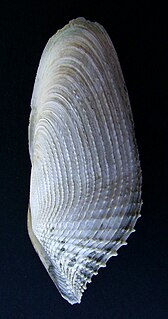 W
WBarnea similis, a rock borer or piddock, is a marine bivalve mollusc in the family Pholadidae.
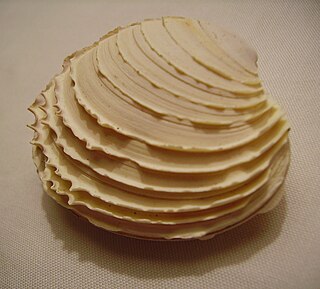 W
WBassina is a genus of bivalve molluscs in the family Veneridae.
 W
WBassina yatei is a bivalve mollusc of the family Veneridae.
 W
WChlamys zeelandona is a bivalve mollusc of the family Pectinidae.
 W
WCleidothaerus albidus is a bivalve mollusc of the family Cleidothaeridae, the only member of its genus and family. It is endemic to southeast Australia and the North Island of New Zealand, including the Chatham Islands.
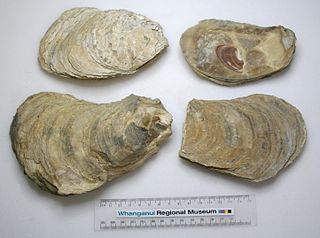 W
WCrassostrea ingens is a species of fossil oyster, a marine bivalve mollusk in the family Ostreidae, the oyster. This species lived during the Pliocene. Fossils have been found in New Zealand shallow-water limestone and shellbeds. Locations include the Wairarapa, Whanganui basin, Gisborne district, North Canterbury, and Hawke's Bay.
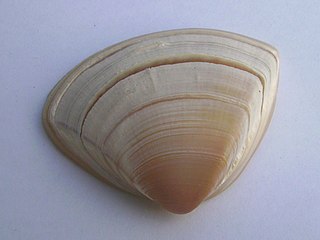 W
WCrassula aequilatera, known as the triangle shell, is a surf clam, a moderately large marine bivalve mollusc in the family Mactridae.
 W
WDiplodonta globus is a species of marine bivalve mollusc in the family Ungulinidae.
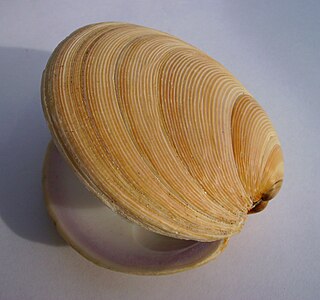 W
WDosinia anus, commonly named the ringed dosinia, coarse dosinia, coarse biscuit shell and tuangi-haruru, in the Māori language, is a species of saltwater clam, a marine bivalve mollusc in the family Veneridae, the venus clams. The species is common to both of the main islands of New Zealand, where it is the largest and heaviest species in the genus, occasionally exceeding 80 mm in diameter. It buries itself in clean fine sandy substrata, sub-tidally down to 15 m deep.
 W
WDosinia maoriana is a medium-sized marine clam, a bivalve mollusc of the family Veneridae, or Venus clams.
 W
WThe dredge oyster or Bluff oyster, Ostrea chilensis, known in Chile as ostra chilena, the Chilean oyster, is a species of marine bivalve mollusc in the family Ostreidae.
 W
WEchyridella menziesii, the New Zealand freshwater mussel, also known by its Māori names kākahi, kāeo, and torewai, is a species of freshwater mussel endemic to New Zealand. E. menziesii is an aquatic bivalve mollusc in the family Unionidae, the river mussels.
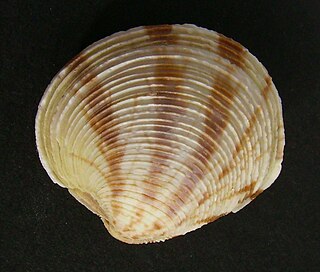 W
WFelaniella zelandica is a species of medium-sized marine bivalve mollusc in the family Ungulinidae.
 W
WGari convexa is a bivalve mollusc of the family Psammobiidae.
 W
WGlycymeris modesta, or the small dog cockle, is a marine bivalve mollusc in the family Glycymerididae.
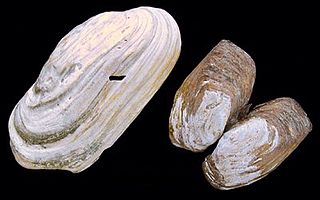 W
WHiatella arctica, known as the wrinkled rock-borer, the arctic hiatella or the arctic saxicave, is a species of saltwater clam, a marine bivalve mollusc in the family Hiatellidae. The white shell of this mollusc is thick and more or less rectangular, but generally irregular in shape. It is up to 45 mm long.
 W
WIrus elegans is a bivalve mollusc of the family Veneridae.
 W
WLima colorata zealandica is a subspecies of bivalve mollusc in the family Limidae.
 W
WLimatula maoria is a species of bivalve mollusc in the family Limidae.
 W
WLithophaga truncata is a date mussel, a marine bivalve mollusc in the family Mytilidae.
 W
WLongimactra is a genus of large marine bivalve molluscs or clams, in the family Mactridae.
 W
WLongimactra elongata is a species of large bivalve mollusc in the family Mactridae.
 W
WMacomona liliana, or the large wedge shell, is a bivalve mollusc of the family Tellinidae.
 W
WMactra ovata is a trough shell of the family Mactridae.
 W
WMesopeplum is a genus of scallops, marine bivalve molluscs in the family Pectinidae.
 W
WMesopeplum convexum is a species of scallop, marine bivalve molluscs in the family Pectinidae.
 W
WModiolarca impacta is a species of saltwater clam, a mussel, a marine bivalve mollusk in the family Mytilidae, the mussels.
 W
WModiolus americanus, or the bearded horse-mussel a species of bivalve mollusc in the family Mytilidae. It is found in New Zealand. Its shell typically is 90 millimetres (3.5 in).
 W
WMonia zelandica, is a species of marine bivalve mollusc in the family Anomiidae, the jingle shells.
 W
WNotirus reflexus is a bivalve mollusc of the family Veneridae
 W
WNotocallista is a genus of marine bivalve molluscs in the family Veneridae.
 W
WNotocallista multistriata is a marine bivalve mollusc in the family Veneridae
 W
WNucula rossiana is a saltwater nut clam, a marine bivalve mollusc in the family Nuculidae.
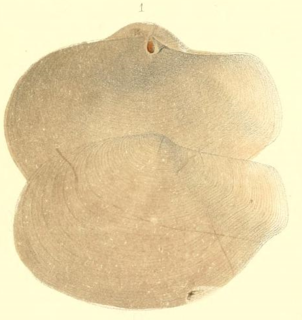 W
WOffadesma angasi is a bivalve mollusc of the family Periplomatidae.
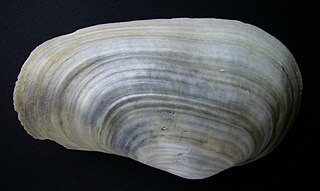 W
WPanopea zelandica, commonly known as the deepwater clam or New Zealand geoduck, is a large species of marine bivalve mollusc in the Panopea (geoduck) genus of the family Hiatellidae. It is also sometimes called a king clam, or a gaper – in reference to the shell not being closed at either end.
 W
WPaphies is a genus of large, edible, saltwater clams, marine bivalve molluscs in the family Mesodesmatidae. The genus is endemic to New Zealand. The species in this genus include the pipi, tuatua and toheroa.
 W
WPaphies australis or pipi is a bivalve mollusc of the family Mesodesmatidae, endemic to New Zealand.
 W
WPaphies ventricosa, or toheroa, is a large bivalve mollusc of the family Mesodesmatidae, endemic to New Zealand.
 W
WPecten novaezelandiae, common name the New Zealand scallop, is a bivalve mollusc of the family Pectinidae, the scallops. Its name is sometimes found misspelt as Pecten novaezealandiae.
 W
WPerna canaliculus, the New Zealand green-lipped mussel, also known as the New Zealand mussel, the greenshell mussel, kuku, and kutai, is a bivalve mollusc in the family Mytilidae. P. canaliculus has economic importance as a cultivated species in New Zealand.
 W
WPratulum is a genus of marine bivalve molluscs in the family Cardiidae.
 W
WPratulum pulchellum is a species of cockle, a marine bivalve mollusc in the family Cardiidae.
 W
WPurpurocardia purpurata is a marine bivalve mollusc in the family Carditidae. Its genus was long included in Venericardia, but is increasingly treated as distinct.
 W
WRuditapes largillierti is a saltwater clam, a marine bivalve mollusc in the family Veneridae, the Venus clams. They are moderately large for their genus, elongate and subrectangular, thick and solid, with smooth ventral margin.
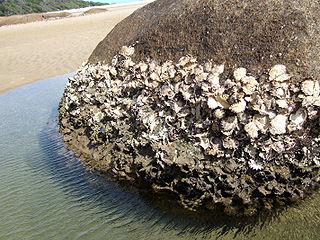 W
WSaccostrea glomerata, is an oyster species endemic to Australia and New Zealand. In Australia, it is known as the Sydney rock oyster and is commercially farmed. In New Zealand, where the species is not farmed, it is known as the New Zealand rock oyster or Auckland oyster. The species is closely related to Saccostrea cucullata, the hooded oyster, which is common on Indo-Pacific rocky shores.
 W
WSolemya velum, the Atlantic awning clam, is a species of marine bivalve mollusc in the family Solemyidae, the awning clams. This species is found along the eastern coast of North America, from Nova Scotia to Florida.
 W
WSoletellina nitida, commonly known as the shining sunset shell, is a bivalve mollusc of the family Psammobiidae.
 W
WTalochlamys zelandiae, common name the New Zealand fan shell, is a bivalve mollusc of the family Pectinidae, the scallops.
 W
WTawera spissa, the morning star shell, is a species of marine bivalve from the Veneridae family. T. spissa is endemic to New Zealand.
 W
WPaphies subtriangulata is a species of edible bivalve clam known as tuatua in the Māori language, a member of the family Mesodesmatidae and endemic to New Zealand. It is found on all three of the main New Zealand islands, buried in fine clean sand on ocean beaches.
 W
WTucetona laticostata, or the large dog cockle, is a salt water clam or marine bivalve mollusc in the family Glycymerididae.
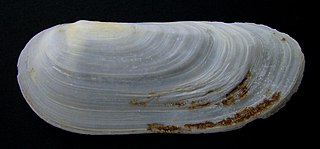 W
WZenatia is a genus of medium-sized clams, marine bivalve molluscs in the family Mactridae.
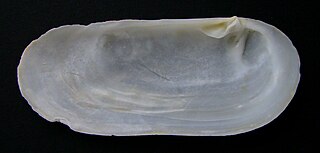 W
WZenatia acinaces is a species of moderately large marine bivalve mollusc in the family Mactridae.